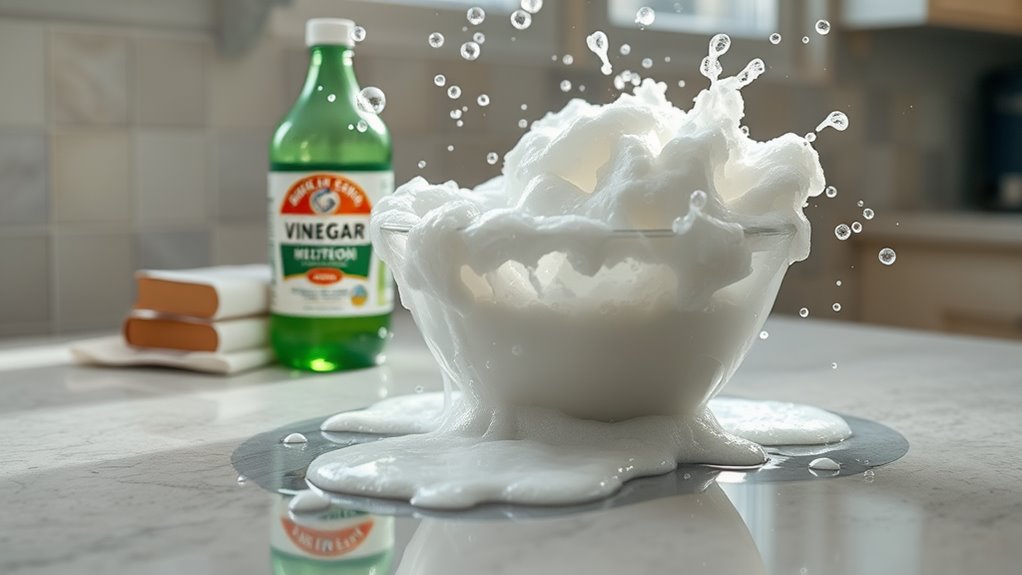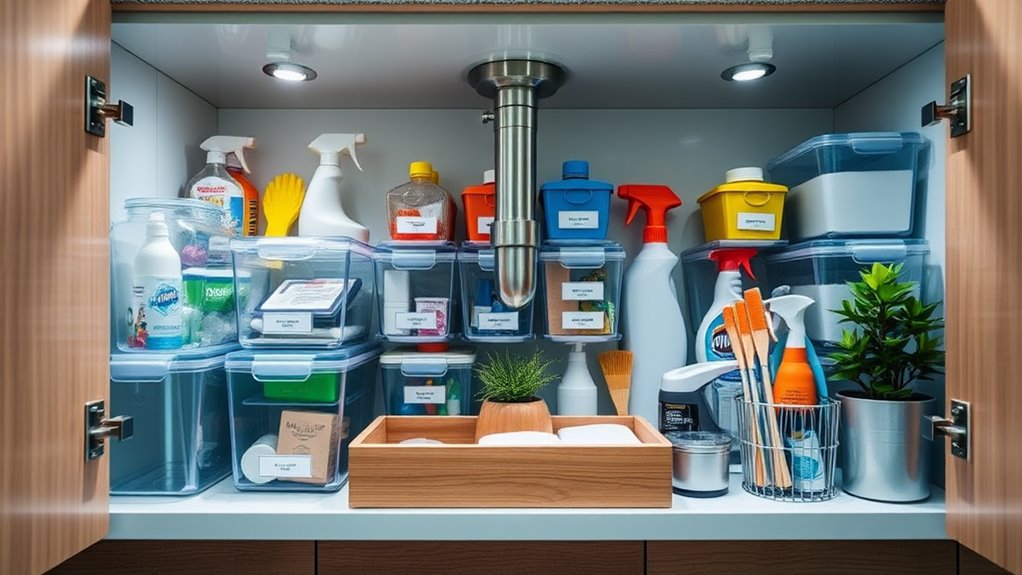The Vinegar + Baking Soda Cleaning Mistake You’re Probably Making
You might think mixing vinegar and baking soda boosts your cleaning power, but that’s a common mistake. This combination neutralizes their strengths and creates sodium acetate, which doesn’t clean effectively. The reaction produces water that dilutes the cleaning properties even further. Instead, use vinegar or baking soda separately for the best results. Curious about how to maximize their effectiveness or explore better alternatives? There’s more to uncover that can improve your cleaning routine.
Key Takeaways
- Mixing vinegar and baking soda creates sodium acetate and water, which lack effective cleaning properties compared to their individual strengths.
- Expecting vinegar and baking soda to work miracles can lead to frustration due to their limited effectiveness on tough stains and odors.
- Using them together dilutes their cleaning power, reducing surface interaction and overall effectiveness.
- Vinegar can damage certain surfaces, like natural stone, making it crucial to understand the best applications for each ingredient.
- Consider alternative cleaning methods, like hydrogen peroxide or enzymatic cleaners, for better results in tackling tough cleaning tasks.
The Science Behind Vinegar and Baking Soda
When you mix vinegar and baking soda, a fascinating chemical reaction occurs that can help with cleaning tasks. This reaction produces carbon dioxide gas, which creates those bubbly fizzing sensations you see.
However, many overlook a common vinegar mistake: using them inappropriately. The acetic acid in vinegar and the sodium bicarbonate in baking soda neutralize each other, leading to a loss of their individual cleaning power. Instead of harnessing their strengths, you might dilute their effectiveness. The result is that the combination mostly yields water and sodium acetate, which are less effective cleaning agents. Using natural alternatives can be a more effective choice for cleaning various surfaces. For instance, using baking soda alone can help unclog drains effectively when combined with hot water.
To master this cleaning duo, use vinegar for descaling or deodorizing, and reach for baking soda when tackling tough stains or odors. Vinegar is known for its antibacterial properties and using them separately allows you to maximize their potential and avoid costly cleaning errors. By understanding the science behind this combination, you can maximize their potential and avoid costly cleaning errors.
Common Misconceptions About Their Effectiveness
You might think vinegar and baking soda are a miracle cleaning duo, but that’s not always the case.
Many people misunderstand how their chemical reactions work, leading to less effective cleaning results. Additionally, using common household products improperly can inadvertently damage surfaces over time. Plus, their usefulness is often limited to specific scenarios, which can leave you frustrated if you’re expecting a one-size-fits-all solution. Additionally, natural ingredients like lemon juice and essential oils can sometimes provide better results for certain cleaning tasks. For example, affordable cleaning solutions with everyday ingredients can often outperform this duo in specific situations. Incorporating natural oven cleaning methods can also enhance your overall cleaning routine without harmful chemicals. A great alternative is using citrus peels which can boost the cleaning power of vinegar and leave a fresh scent.
Misunderstanding Chemical Reactions
Although many people believe that combining vinegar and baking soda creates a powerful cleaning solution, this misconception stems from a misunderstanding of their chemical reactions.
When you mix these two substances, they react to produce carbon dioxide gas, resulting in fizzing and bubbling. While this reaction can be visually impressive, it doesn’t yield a potent cleaner.
Instead, the acid in vinegar neutralizes the base in baking soda, diminishing their individual cleaning properties. For effective cleaning, it’s essential to use them separately, capitalizing on vinegar’s ability to dissolve mineral deposits and baking soda’s mild abrasive qualities.
Understanding these chemical interactions empowers you to use each ingredient to its fullest potential, enhancing your cleaning strategies.
Limited Cleaning Applications
Many people mistakenly believe that vinegar and baking soda can tackle a wide range of cleaning tasks effectively.
However, their effectiveness is limited, and using them indiscriminately can lead to disappointing results.
Here are some common misconceptions about their cleaning applications:
-
Stains: They may not remove tough stains like red wine or grease.
-
Disinfection: They don’t kill all germs; for that, you need a dedicated disinfectant.
-
Odor Removal: They can neutralize some odors, but not all, especially persistent ones.
-
Surface Compatibility: Certain surfaces, like natural stone, can be damaged by vinegar.
Understanding their limitations helps you choose the right tools for the job, ensuring your cleaning efforts yield the results you desire.
The Neutralization Reaction Explained
When vinegar and baking soda come together, they trigger a fascinating neutralization reaction that produces carbon dioxide gas, water, and sodium acetate.
This reaction occurs because vinegar, an acid (acetic acid), reacts with baking soda, a base (sodium bicarbonate). As they mix, the acid donates protons to the base, leading to the formation of water and carbon dioxide—visible as fizzing bubbles.
Understanding this reaction is essential for mastering their use in cleaning. While the effervescence might seem impressive, it’s important to recognize that this process also neutralizes the cleaning properties of both substances.
In your quest for effective cleaning solutions, it’s critical to know when and how to utilize vinegar and baking soda separately for best results.
Why Water and Sodium Acetate Don’t Clean
While it might seem logical to assume that water and sodium acetate could provide effective cleaning power, they actually fall short in that regard.
Sodium acetate isn’t a strong enough cleaning agent on its own, and when combined with water, it fails to break down grime effectively. Here’s why:
-
Lack of Surfactants: Sodium acetate doesn’t contain surfactants, which are essential for lifting dirt and oils. Additionally, natural disinfectants often include surfactants that enhance cleaning efficacy. Using natural surfactants can significantly boost the cleaning power of homemade solutions. DIY cleaning sprays typically incorporate these essential components for better results. Furthermore, natural cleaning solutions often utilize vinegar and essential oils for their superior antimicrobial properties.
-
Limited Reactivity: It doesn’t react with stains or debris the way other cleaners do.
-
Dilution Issues: Water can dilute its effectiveness, making it less potent in tackling messes.
-
Surface Interaction: It doesn’t bind well to surfaces, leading to poor cleaning results.
For serious cleaning, you’ll need to rely on more effective agents. Additionally, opting for natural cleaners can provide a safer and eco-friendly alternative to harsh chemicals.
Effective Ways to Use Vinegar Alone
Although vinegar is often overlooked as a cleaning agent, it can be incredibly effective on its own. Use white vinegar to tackle hard water stains by soaking a cloth and applying it to affected areas.
For windows, mix equal parts vinegar and water in a spray bottle for a streak-free shine. Got stubborn odors? Place a bowl of vinegar in the fridge or any smelly room to neutralize them.
Vinegar also excels at cutting through grease; spray it on greasy surfaces, let it sit for a few minutes, then wipe clean. Don’t forget about your laundry—adding a cup of vinegar can help brighten whites and eliminate odors.
Master these techniques, and you’ll harness the true power of vinegar in your cleaning routine.
Effective Ways to Use Baking Soda Alone
Baking soda is a versatile cleaning agent that can tackle a variety of household issues.
You can effectively neutralize odors, remove stubborn stains, and scrub surfaces with this simple ingredient.
Let’s explore some practical techniques to get the most out of baking soda in your cleaning routine.
Odor Neutralization Techniques
When you’re dealing with unwanted odors in your home, turning to baking soda can be your best bet for effective neutralization. This versatile powder absorbs smells rather than just masking them.
Here are some techniques to master:
-
Place open containers filled with baking soda in areas like the fridge or pantry to absorb odors.
-
Sprinkle baking soda on carpets and upholstery, let it sit for at least 15 minutes, then vacuum to remove stale smells.
-
Use a baking soda paste (mix with a little water) to scrub surfaces in areas like the kitchen or bathroom.
-
Add baking soda to laundry to freshen clothes and eliminate odors from fabrics.
With these techniques, you’ll effectively maintain a fresh-smelling home.
Stain Removal Methods
If you want to tackle tough stains effectively, using baking soda can be a game changer. Start by creating a paste with water and baking soda, then apply it directly to the stain. Let it sit for about 15-30 minutes to permit the baking soda to penetrate the fibers.
For grease stains, sprinkle baking soda directly on the spot, then scrub gently with a damp cloth. Rinse thoroughly afterward.
For fabric stains, you can mix baking soda with white vinegar, but avoid combining them prematurely, as that creates a fizzing reaction that limits effectiveness.
Always test any solution on a discreet area first to verify it won’t damage the material. Master these techniques, and you’ll see impressive results!
Surface Scrubbing Tips
While you might think of baking soda as just a baking ingredient, it’s an excellent choice for surface scrubbing too. This versatile powder can tackle grime and stains effectively when used correctly.
Here are some tips to master the art of scrubbing with baking soda:
-
Create a paste: Mix baking soda with water for a powerful scrubbing solution.
-
Use a soft cloth: Apply the paste with a microfiber cloth to avoid scratching surfaces.
-
Let it sit: Allow the paste to sit for 10-15 minutes on tough stains for better results.
-
Rinse thoroughly: Always rinse the surface with water after scrubbing to remove residue.
Alternative Cleaning Methods for Better Results
Although vinegar and baking soda are popular cleaning agents, exploring alternative methods can lead to even better results.
For instance, consider using hydrogen peroxide for disinfecting surfaces. It’s effective against germs and doesn’t leave a strong odor.
Enzymatic cleaners are another great option, especially for organic stains like food or pet messes. They break down stains at a molecular level, making cleanup easier.
If you want a natural fragrance, essential oils mixed with castile soap can elevate your cleaning routine. You’ll not only clean effectively but also enjoy a pleasant aroma.
Finally, microfiber cloths can enhance your cleaning by trapping dirt and dust more efficiently than traditional rags.
Embrace these alternatives for a cleaner, healthier environment!
Frequently Asked Questions
Can Vinegar and Baking Soda Be Stored Together Safely?
You shouldn’t store vinegar and baking soda together, as their reaction creates carbon dioxide gas. This can lead to pressure buildup in a sealed container, potentially causing a mess or even damage. Keep them separate for safety.
Are There Any Harmful Reactions Between Vinegar and Baking Soda?
There aren’t harmful reactions between vinegar and baking soda; they simply neutralize each other. When combined, you create carbon dioxide, resulting in fizzing. Use them separately for effective cleaning without wasting their individual strengths.
What Surfaces Should I Avoid Using Vinegar On?
You should avoid using vinegar on natural stone surfaces like granite or marble, as it can etch and damage their finish. Additionally, steer clear of using it on wood, as it may strip protective coatings.
Can I Use Vinegar and Baking Soda for Laundry?
You can use vinegar and baking soda for laundry to boost cleaning power and eliminate odors. Just add them separately during the wash cycle; don’t mix them directly, or you’ll lose effectiveness. Happy laundering!
How Do I Remove Odors With Just Baking Soda?
To remove odors with just baking soda, sprinkle it generously on affected areas. Let it sit for a few hours, then vacuum it up. This method effectively absorbs and neutralizes unwanted smells, leaving your space fresh.



